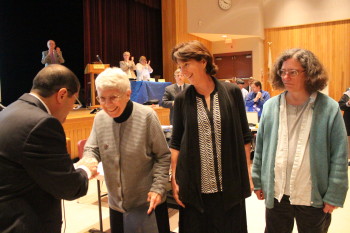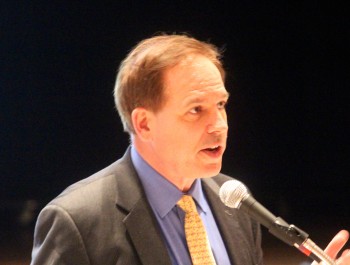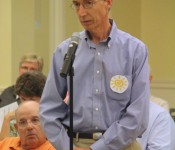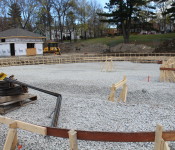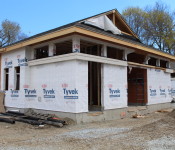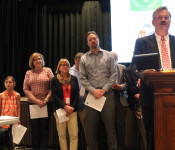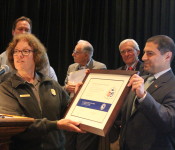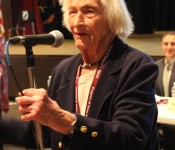Photo: The “access” road in front on Belmont Savings Bank.
The planning took four year to finalize, the blueprints were drawn, the contractors hired and the work underway.
And for those who worked to bring the Belmont Center Reconstruction project to fruition, it appeared that all that was left was for a ribbon cutting late in the year to celebrate the upgrade to the roadway, new sidewalks and other amenities that is expected to last for the next half century.
But being Belmont, the final word is never the last say.
Despite a half decade of public meetings led by the Belmont Traffic Advisory Committee and with workers tearing up curbing and cutting trees beginning last week, the Belmont Board of Selectmen called a special meeting for Thursday, May 28 at the Beech Street Center to hear from some of the apparently 200 residents who decided the last second was an appropriate time to be heard about the entire project.
Led by 96-year-old Lydia Phippen Ogilby of Washington Street who took pencil to paper to call for the meeting to hear from the signatories – many who are north of Belmont’s median age of 42 – who felt passed over on the opportunity to express their concerns on the finished design, submitted their own “Plan B” revision.
Saying the reconstruction will be with the town for more than a half century, Selectmen Chair Sami Baghdady said aspects of the project “raised so much concern” that despite the lateness of the challenge, the meeting was warranted in an effort to find a “revenue neutral way” to find a compromise.
In fact, the opponents were apparently perturbed with just a pair of the design’s details; the removal of about 10 diagonal parking spaces located in front of the Belmont Savings Bank headquarters at 2 Leonard St., and the related one-way “access” road – actually the currently parking area – connecting Moore Street with Concord Avenue.
Under the TAC design plans approved by d the Board of Selectmen and reviewed by a Special Town Meeting in November when it approved a funding package, the parking spaces and road were removed to create a “Town Green” in front of the bank, with benches and a flag pole that would attract residents and visitors to a central landmark Belmont Center.
“It provides Belmont a ‘green’ which many towns have but we have been lacking,” Glenn Clancy – as director of the Community Development Office is overseeing the project for the town – told the Belmontonian before the meeting.
In the current plan, known as Plan A at the meeting, there would be three parking spaces next to the existing exit from the bank’s covered parking garage with additional parking spaces created near by along Concord Avenue near Town Hall.
While the meeting was established to hear from critics, most speakers expressing opinions were supportive of the current design.
“It would be a big mistake to change the new design,” said former State Rep. and Selectman Anne Paulsen, saying the “town green” concept would make the site “a friendlier space” while keeping parking and the access road will result in the space that “only a few people” would want to spend time.
Paul Rickter of Cross Street approved eliminating the cut-through from Moore to Concord as it would make the center “a little more pedestrian-friendly.”
While supporters were , the tardy opponents were not satisfied with the design as it would effect how they conduct business especially at Belmont Savings’ main branch.
The second design – supported by the petitioners – would revert the Green back to a tear-shaped island surrounded by traffic and parking while keeping the “short cut” from Moore to Concord, which several residents note is a convenience so not having to enter onto Leonard Street to turn right onto Concord.
Joel Semuels of Bellevue Road, who is on the board for the town’s Council on Aging, said reduction of parking spaces would be a detriment to the “25 percent of residents over 60” (Editor’s note: the 2010 US Census data indicated that 16 percent of Belmont residents are 65 years old and older) seeking to do business at the bank. Semuels approved of four parallel spaces situated before the bank’s garage exit in the Plan B scheme.
Scott Tellier, who with his father owns commercial property in Belmont Center, said preserving parking spaces – even three or four that will be “lost” in the entire project – was paramount for stores and restaurants to retain customers seeking to shop in the commercial hub.
“We want to see parking,” said Tellier.
Bob Mahoney, the president and CEO of Belmont Savings, said he could support the changes begin proposed although he did want to promote the green space adjacent the bank. He noted even under Plan B, the green will increase by approximately 40 percent from its present footprint.
The dilatory nature of the opponent’s complaints, as well as their insistence their concerns were not incorporated into the reconstruction’s plans, did not sit well with Linda Nickens, TAC chair who pointedly told the few opponents in attendance the committee didn’t sit “in a dark room” developing the project, which, she added, was viewed favorably by the selectmen and the business community last year.
“They did like it,” said Nickens.
With numerous public meeting TAC set aside to hear from all sides of the measure, the opponents “never came to complain” or be part of the process, said Nickens, calling the belated campaign to alter the plans “disappointing.”
As a supporter of the current plan, Rickter said his objection with the meeting is that “this change was made at the eleventh hour with no clear notice that the Selectmen would be making such a substantial change to the design.”
“We don’t know if they are representative of the town as a whole or merely a very vocal minority; the process never allowed us to find that out,” he told the Belmontonian.
Given the last say, Ogilby – whose family first ventured into what is now Belmont in the 1600s – expressed her feelings in a labyrinthine statement, in which she complimented Clancy, talked about the news about town, how she likes the traffic roundabout in front of her house at the corner of Grove and Washington, and all the “nice” residents near her 19th-century farm house for signing the “papers.”
In the end, the selectmen unanimously voted to support Plan B which the opponents championed. Baghdady, who earlier called the changes “tweaking” he current plan, hailed the changes as “part of the democratic process.” Even Nickens agreed that “the people have spoken” on the matter.
